
The Alabama Center for Ecological Resilience (ACER) blog hosted a series of posts discussing the meaning behind various terms and concepts that are important to ACER research.


The Alabama Center for Ecological Resilience (ACER) blog hosted a series of posts discussing the meaning behind various terms and concepts that are important to ACER research.

Meiofauna are microscopic marine organisms that live between grains of sand in ocean, coastal, river, and stream sediments and provide important services such as recycling organic material in the sediment that contribute to healthy marine ecosystems. Additionally, meiofauna are intermediary consumers between microbes and prey of larger organisms in marine food webs, and as such, can be early indicators of environmental disturbances, such as oil spill pollution, that could affect broader ecosystem health.
Joseph Sevigny uses genetic research techniques to expand our knowledge about meiofauna taxonomy and improve the way we analyze and monitor these communities. His work to develop novel methods for efficient genomic analysis can reduce the time it takes researchers and responders to survey and monitor how meiofaunal communities recover from environmental disturbances.
Joseph is a Ph.D. student with the University of New Hampshire’s Hubbard Center for Genome Studies and a GoMRI Scholar with the project Genomic Responses to the Deepwater Horizon Event and Development of High-Throughput Biological Assays for Oil Spills.
His Path
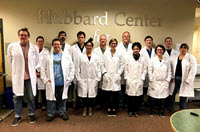
Joe has been fascinated with understanding how the natural world works since he was a child. Reading scientific authors such as Matt Ridley and Richard Dawkins sparked his interest in the engaging world of genetics, genomics, and computational biology. He began his undergraduate career as a Biology and Environmental Science dual major at New England College and conducted bioinformatics and genetics research full-time during the summer of his junior year. He collaborated with several institutions, including the University of New Hampshire’s Hubbard Center for Genome Studies, where he learned about Dr. Kelley Thomas’s GoMRI-funded research characterizing the taxonomy of benthic organisms such as meiofauna.
Joe’s work during that summer solidified his passion for comparative genomics research, and he later joined Dr. Thomas’s lab as a Ph.D. student. “Meiofauna don’t have the means to move to a different location after an environmental disturbance – they are stuck dealing with whatever comes into their homes,” he explained. “I want to help improve the way we analyze and monitor these communities through DNA sequencing and highlight their importance for investigating the impacts of oil spills.”
His Work
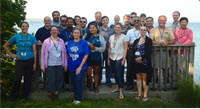
The first and most challenging step of Joe’s research was collecting and preparing the meiofauna for genomic analysis. Because most meiofauna species have not undergone genetic sequencing, he had to start from scratch. Joe and his colleagues developed techniques to sequence trace amounts of DNA from meiofauna but still needed to taxonomically identify them before they could proceed.
Since they are investigating a broad group of meiofauna (26 of the 35 known animal phyla), they needed help from taxonomic experts, so the team coordinated workshops such as the Benthic Invertebrate Taxonomy, Metagenomics, and Bioinformatics (BITMaB) with invited meiofaunal taxonomists from around the world. During the workshop, attendees collected and identified Gulf of Mexico meiofauna, which allowed them to sequence an extremely broad range of meiofaunal groups.
“This monumental task would have been impossible without collaborating with traditional taxonomists, who collect and identify individual animals using light microscopy and other techniques,” said Joe. “Through the workshops, the taxonomists got to learn how we analyze the data during bioinformatics sessions, and we were able to learn a lot about the process of collecting and identifying a diverse array of meiofaunal species. It was a win-win for us all!”

Joe extracted and prepared DNA from the identified specimens for genetic sequencing, which provided him with short DNA fragments. He then used bioinformatics principles to develop his own computer code for existing software to analyze the genetic data. His program assembled the short DNA fragments into complete genomes, expanding them to the size of a chromosome. He then analyzed the genes in the large sequences to determine what functions the meiofauna have, the biochemical processes they are capable of, and their evolutionary relationships.
Joe’s research will help reduce the time and effort involved in monitoring meiofaunal communities. Rather than going through the expensive, time-consuming taxonomic identification process, future researchers can sequence DNA directly from an environmental sample, link the resulting sequences to the database, and infer which meiofauna are present. “This process will allow for faster, broader, and more-accurate scale analyses of meiofaunal communities and populations than ever before, allowing us to determine which areas of the Gulf are most severely impacted and focus our recovery efforts on those places,” explained Joe. “Over time, we can utilize the same data to monitor how these communities are recovering and construct baseline data across the Gulf and around the world.”
His Learning
Joe worked on different projects during his time with Dr. Thomas, including research focusing on animal phylogeny and evolution, speciation, and developmental expression experiments. These diverse projects helped balance his background in computational genomics. The genomic workshops gave Joe an opportunity to share his computational methods knowledge while learning from experts in different fields and were a highlight of his graduate studies.

“I find it extremely rewarding that I can incorporate my skillset in molecular biology towards increasing our understanding and awareness of anthropogenic impacts,” he said. “Teaching a topic I really enjoy and sharing my knowledge with the next generation of scientists is extremely rewarding and motivating. These experiences have really shown me how much science benefits from an environment in which scientists from an extremely broad set of backgrounds come together for a common goal.”
His Future
Joe plans to continue his genomics research as a post-doc and eventually serve in a faculty position.
Praise for Joe
Dr. Thomas explained that Joe has a “uniquely engaging quality” that makes it easy for him to work alongside diverse collaborators from other fields. He particularly recalled Joe’s appreciation for the taxonomists and ecologists who participated in the workshops and their reciprocal appreciation for Joe’s ability to teach them the bioinformatics needed to utilize his team’s genomic data. “I believe his success stems from the fact that Joe is genuinely interested in their work,” he said.
Dr. Thomas also praised Joe’s teaching ability. Joe teaches a week-long summer course for college instructors called Train the Trainers (T3), which is based off of the bioinformatics workshop he helped develop for the GoMRI project. “Joe loves what he does, and it shows. He always receives rave reviews and requests to teach,” said Dr. Thomas. “He has contributed mightily to our GOMRI project and has a great career ahead of him using the skills that he developed during this project.”
The GoMRI community embraces bright and dedicated students like Joe Sevigny and their important contributions. The GoMRI Scholars Program recognizes graduate students whose work focuses on GoMRI-funded projects and builds community for the next generation of ocean science professionals.
By Stephanie Ellis and Nilde Maggie Dannreuther. Contact sellis@ngi.msstate.edu for questions or comments.
************
The Gulf of Mexico Research Initiative (GoMRI) is a 10-year independent research program established to study the effect, and the potential associated impact, of hydrocarbon releases on the environment and public health, as well as to develop improved spill mitigation, oil detection, characterization and remediation technologies. An independent and academic 20-member Research Board makes the funding and research direction decisions to ensure the intellectual quality, effectiveness and academic independence of the GoMRI research. All research data, findings and publications will be made publicly available. The program was established through a $500 million financial commitment from BP. For more information, visit https://gulfresearchinitiative.org/.
© Copyright 2010-2019 Gulf of Mexico Research Initiative (GoMRI) – All Rights Reserved. Redistribution is encouraged with acknowledgement to the Gulf of Mexico Research Initiative (GoMRI). Please credit images and/or videos as done in each article. Questions? Contact web-content editor Nilde “Maggie” Dannreuther, Northern Gulf Institute, Mississippi State University (maggied@ngi.msstate.edu).

Phytoplankton and bacteria in the northern Gulf of Mexico interact closely at the food web base and provide vital food and nutrients to marine life at higher trophic levels. During the Deepwater Horizon incident, these pervasive organisms played an important role in oil bioremediation before and after the application of chemical dispersants, which broke up surface slicks into smaller droplets and enhanced microbial degradation. Samantha “Sam” Setta, who recently completed her master’s degree, used molecular-level techniques to learn how oil and dispersant exposure affects the abundance of and interactions between Gulf bacteria and phytoplankton.
Sam recently graduated from the Texas A&M University at Galveston’s Marine Biology Department and was a GoMRI Scholar with the Aggregation and Degradation of Dispersants and Oil by Microbial Exopolymers (ADDOMEx) consortium.
Her Path
Sam’s interest in a scientific career was sparked by a high school aquatic science class that emphasized marine science and conservation. As a freshman at the University of Texas at Austin, she changed her major from chemistry to biology to physics and ultimately settled on marine biology with a focus on freshwater.
“Growing up in Austin, I was surrounded by parks, lakes, and natural springs that influenced my thinking of the world and led me to an interest in conservation, especially water conservation,” said Sam. She enhanced her undergraduate education by conducting research in Mexico and working with a graduate student at the university’s Marine Science Institute, which provided work experience and insight into graduate student life.
However, Sam was still unsure about pursuing a graduate degree and decided to explore different fields to pinpoint her passion. She worked as a research technician on algal biofuel in Texas and later as a research associate with Dr. Brian Roberts studying the Deepwater Horizon’s effects on Louisiana salt marsh vegetation and biogeochemistry. The oil spill research inspired her to pursue graduate school, and she began her master’s studies with Dr. Antonietta Quigg at Texas A&M University at Galveston investigating the spill’s effects on microbial community composition.
Her Work
Phytoplankton are microscopic photosynthesizers that transform atmospheric carbon dioxide into food for grazers and other microscopic heterotrophs. Bacteria then recycle the used carbon into a form that heterotrophs can eat again, starting a microbial loop of recycling and reusing organic carbon. Sam’s research as a master’s student was to learn how oil and dispersant may have affected these microbial interactions.
Sam and her colleagues incubated Gulf of Mexico microbial communities with different oil and oil plus dispersant concentrations in large tanks that mimicked conditions around the spill area. She extracted DNA from bacteria in tank water samples, amplified identifiable DNA regions using polymerase chain reactions, and measured and recorded nucleotides using DNA sequencing techniques. Sam is using the sequencing data to characterize the composition of bacterial and phytoplankton communities under different exposure scenarios.
Samantha is now a Ph.D. student at the University of Rhode Island and continues her oil spill research in her free time. She is currently analyzing the bacteria-phytoplankton interactions for each exposure using a network analysis that correlates community composition over time under different oil and dispersant exposures. Her findings will ultimately identify taxa that play a key role in oil bioremediation, their correlation with certain phytoplankton and other eukaryotic organisms, and how oil and dispersant exposure change these taxa.
“Highlighting the key players that respond to spilled oil will help better direct future studies and oil spill mitigation,” explained Sam. “This information can be used to target key taxa in other laboratory studies and provide more information to policy makers on the pros and cons of using dispersant in the event of an oil spill.”
Her Learning
Sam’s research provided her with frequent experience working in a collaborative environment. She described her time with Dr. Quigg’s group as encouraging and enriching, “I found that the tank experiments we did once a year with the entire research consortium were the best time to collaborate and get to know the research everyone else was doing as part of the project. Everyone involved in the ADDOMEx consortium has been very supportive.”
Her Future
Sam recently began Ph.D. studies in oceanography at the University of Rhode Island Graduate School of Oceanography. She suggests that students use their time in graduate school to learn where their interests lie before committing to a specific scientific career.
Praise for Samantha
Dr. Quigg described Sam as a student who is smart, determined, and fun to work with. She explained that despite Sam’s complex master’s research for the ADDOMEx consortium and her tremendous determination and ability to work well with others made her project a success. “Sam was one of those students who you meet and immediately know they will be both a great scientist and colleague,” said Quigg. “Her research required her to work on the cutting edge of a variety of disciplines, and she rose to the challenge and even finished her master’s in two years. I look forward to watching her continue to develop her craft as she starts her Ph.D. at the University of Rhode Island this fall.”
The GoMRI community embraces bright and dedicated students like Samantha Setta and their important contributions. The GoMRI Scholars Program recognizes graduate students whose work focuses on GoMRI-funded projects and builds community for the next generation of ocean science professionals. Visit the ADDOMEx website to learn more about their work.
By Stephanie Ellis and Nilde Maggie Dannreuther. Contact sellis@ngi.msstate.edu for questions or comments.
************
The Gulf of Mexico Research Initiative (GoMRI) is a 10-year independent research program established to study the effect, and the potential associated impact, of hydrocarbon releases on the environment and public health, as well as to develop improved spill mitigation, oil detection, characterization and remediation technologies. An independent and academic 20-member Research Board makes the funding and research direction decisions to ensure the intellectual quality, effectiveness and academic independence of the GoMRI research. All research data, findings and publications will be made publicly available. The program was established through a $500 million financial commitment from BP. For more information, visit https://gulfresearchinitiative.org/.
© Copyright 2010-2018 Gulf of Mexico Research Initiative (GoMRI) – All Rights Reserved. Redistribution is encouraged with acknowledgement to the Gulf of Mexico Research Initiative (GoMRI). Please credit images and/or videos as done in each article. Questions? Contact web-content editor Nilde “Maggie” Dannreuther, Northern Gulf Institute, Mississippi State University (maggied@ngi.msstate.edu).
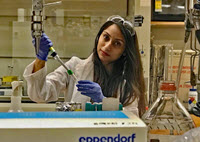
Petroleum hydrocarbons released by oil spills can accumulate on beaches and in nearshore sediments, potentially creating health risks for humans and coastal organisms. However, the highly variable conditions of beach environments make it difficult to determine the long-term behavior and fate of hydrocarbons in sands and sediment. Smruthi Karthikeyan combines bioinformatics and oil degradation data to examine microbial responses to oil in beach environments and identify populations that act as bioindicators of oil degradation and toxicity. Documenting microbial indicators and producing oil degradation models for environmental managers can help with future oil spill response plans for coastal zones.
Smruthi is a Ph.D. student with the Georgia Institute of Technology’s School of Civil and Environmental Engineering and a GoMRI Scholar with the project A Systems Approach to Improve Predictions of Biodegradation and Ecosystem Recovery in Coastal Marine Sediments Impacted by Oil Spill.
Her Path

Smruthi grew up in Chennai, India, near one of the largest beaches in the world, which sparked her interest in environmental health. Later, she completed an undergraduate chemical engineering program at Anna University because of its practical applications. She then transitioned to Columbia University for her master’s environmental engineering studies, which she considers an ideal interdisciplinary field that unites science and technology. “Being in the environmental engineering field gives me a lot of opportunities to view the environment from different perspectives,” she said.
Smruthi’s Ph.D. advisor Dr. Kostas Konstantinidis introduced her to the microbial world during one of his classes. She was intrigued about using bioinformatics to elicit information from such tiny creatures and was curious about the microbial role in environmental pollutant biodegradation. Konstantinidis received GoMRI funding in 2016 to research how microbes respond to oiling and identify indicator species for oil degradation and toxicity in beach sands. Accepting a position on his team made Smruthi excited about combining her love of environmental preservation with microbial genomics.
Her Work
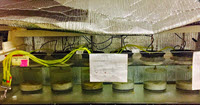
Smruthi conducts laboratory mesocosm experiments that mimic the in situ conditions found in the beach environment. She incubates Pensacola beach sand collected at different times during the Deepwater Horizon incident in six acrylic chambers (three with oiled sand and three with pristine sand) and replicates the tidal cycle by periodically adding and removing water overlying the sand. While sensors monitor pH, oxygen, nutrient, and temperature levels inside the chambers, she collects sand samples at designated time intervals and analyzes the microbial community’s DNA and RNA.
“Thanks to recent developments in cultivation-independent and next-generation sequencing methods, we are able to see microbial communities at a much higher resolution than ever before and identify their activities and nutrient limitations,” said Smruthi. “We can answer not only ‘Who is there?’ but also ‘What are they doing?’ from less than a gram of sand sample.”
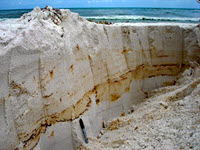
Smruthi’s analyses identify microbial populations with reduced abundance after oil exposure and observe if they return after oil is completely removed. Populations that do not return could warrant further investigation to assess how long it may take an ecosystem to recover after oiling. Her analyses also examine the gene content of individual microbial populations and compare them to hydrocarbons used in the experiment to determine which oil-degrading genes the microbes possess. A microbe that is more abundant after oil exposure may be a viable bioindicator of oil presence and biodegradation processes. Smruthi hopes that comparing her microbial data to the in situ sensor data can help develop an integrated conceptual model that allows predictions of pathways and oil degradation rates needed for future forecasts of recovery pathways.
Smruthi’s analyses have revealed a previously undiscovered microbial genus that was below detection in clean sands but rapidly increased to 30% of the total microbial community in oiled sands. According to publicly available databases, the species appears consistently in oil-contaminated sediments worldwide, particularly as a responder to other major oil spills, while being notably absent in unoiled environments. The microbe is metabolically versatile and can feast on oil and get the nitrogen it needs from the atmosphere, eliminating the need to add potentially harmful fertilizers that encourage microbial oil degradation. “It appears that this microbe belongs to a new genus of keystone oil degraders that has gone unnoticed so far and thus could represent a new model organism for oil bioremediation efforts,” said Smruthi. “We proposed to name this new bacterial genus “Macondimonas,” as we recovered it from the Macondo oil spill.”
Her Learning
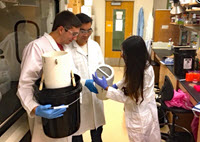
Smruthi’s experiences conducting GoMRI research opened her eyes to many different perspectives of oil spill research. Working with her advisor and their project’s principal investigator Dr. Markus Huettel helped her see the multifaceted aspects of her research, while interacting with scientists from different disciplines broadened her scientific perspective. “As someone who did not have a background in computational biology and marine ecology initially, this GoMRI grant has greatly helped my venture into this new and fascinating area,” she said. “It showed me that there’s a whole new realm out there filled with these microscopic marvels while at the same time integrating my engineering background.”
Her Future
Smruthi hopes to become a professor after completing her Ph.D. She encourages students considering a career in science and technology by telling them, “It is a rewarding and satisfying experience to actually see that your work can someday help the environment and society in whatever little way it can.”
Praise for Smruthi
Konstantinidis said that Smruthi is a hard worker with strong analytical abilities and a tremendous capacity and desire to learn new things. Her contributions helped his team explore new research ideas that resulted in important discoveries, such as the new oil-degrading bacteria. “[Our work with Smruthi] happened due to a bit of good luck,” he said. “When the advisor that Smruthi was working with initially decided to retire, I talked to Smruthi about the GoMRI project, and she got really excited and wanted to join our research team. It was good luck for all of us, I think!”
The GoMRI community embraces bright and dedicated students like Smruthi Karthikeyan and their important contributions. The GoMRI Scholars Program recognizes graduate students whose work focuses on GoMRI-funded projects and builds community for the next generation of ocean science professionals.
************
The Gulf of Mexico Research Initiative (GoMRI) is a 10-year independent research program established to study the effect, and the potential associated impact, of hydrocarbon releases on the environment and public health, as well as to develop improved spill mitigation, oil detection, characterization and remediation technologies. An independent and academic 20-member Research Board makes the funding and research direction decisions to ensure the intellectual quality, effectiveness and academic independence of the GoMRI research. All research data, findings and publications will be made publicly available. The program was established through a $500 million financial commitment from BP. For more information, visit https://gulfresearchinitiative.org/.
© Copyright 2010-2018 Gulf of Mexico Research Initiative (GoMRI) – All Rights Reserved. Redistribution is encouraged with acknowledgement to the Gulf of Mexico Research Initiative (GoMRI). Please credit images and/or videos as done in each article. Questions? Contact web-content editor Nilde “Maggie” Dannreuther, Northern Gulf Institute, Mississippi State University (maggied@ngi.msstate.edu).

Nikaela Flournoy’s scientific journey has always carried a societal tie, from her passion for research’s social relevance to her realizations about the relationship between society and STEM (science, technology, engineering, and math). Though she is excited to see a greater emphasis on STEM in primary and secondary education, she hopes to help expand STEM awareness and curriculum to students from diverse educational and social backgrounds.
Nikaela recently completed her doctoral studies in the University of Alabama’s Department of Biological Sciences and was honored as a GoMRI Scholar with the Alabama Center for Ecological Resilience (ACER). She continues her ACER research as a post-doctoral researcher at the University of Alabama.
Her Path
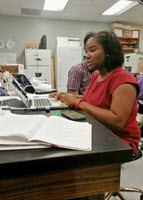
Nikaela learned about the possibilities of scientific research as an undergraduate student at Alabama A&M University. Her high school curriculum included standard science courses but they did not highlight the diverse opportunities a scientific career could hold. “I knew scientific research existed before I attended Alabama A&M, but I didn’t know the scope of it until I was offered the opportunity to work in a research lab,” said Nikaela. She worked as an undergraduate research assistant while completing her biology degree and completed a master’s degree in microbiology at the University of Iowa with a focus on virology.
Nikaela’s educational background provided her with different perspectives in the sciences. While her biology research fostered an interest in environmental microbiology, her virology research generated an awareness about public health and the societal relevance of scientific research. When the 2010 Deepwater Horizon oil spill occurred, Nikaela was still unsure if she wanted to continue her scientific education through a doctoral program. However, the images of the oil as it entered the coastal environment and the expectation of downstream economic impacts inspired her to search for research opportunities where she could use her skillsets for the greater good. “Seeing the graphic imagery within the northern Gulf of Mexico inspired me to pursue research that would utilize my prior skillsets to investigate the interface between the environment and public health,” she said. In 2011, she joined Dr. Patricia Sobecky’s research investigating the long-term effects of Deepwater Horizon on the Alabama coastline, a collaboration with Dr. Behzad Mortazavi’s nitrogen cycling lab at the Dauphin Island Sea Lab (DISL). Their work became part of the ACER project in 2015.
Her Work
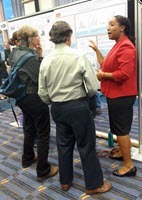
Coastal saltmarshes help remove anthropogenic nitrogen from the coastal ecosystem through processes such as denitrification, a microbial process that reduces nitrate in saltmarsh sediments by releasing it into the atmosphere as nitrogen gas. Large-scale contamination events such as oil spills can potentially cause losses in saltmarsh vegetation, impairing the marsh’s ability to remove nitrogen. Nikaela analyzes DNA in samples from Deepwater Horizon-impacted subtidal and vegetated saltmarshes to understand resident microbes’ presumed contributions to nitrogen removal and its effects on microbial diversity.
Nikaela extracts DNA from sediment samples collected from the Chandeleur Islands five years after it was heavily oiled during Deepwater Horizon and analyzes it using next-generation Illumina sequencing. She applies bioinformatic approaches to determine which bacteria are present and assesses their genetic potential to remove nitrogen. She then compares and contrasts those metrics between saltmarsh conditions to observe how loss of vegetation might impact the marsh’s denitrification potential. So far, Nikaela and her collaborators observed that the average denitrification capacity of vegetated marshes was four-times higher than unvegetated marshes. Denitrifying microbes were equally abundant in both types of marsh, suggesting that vegetation regulates the denitrifiers’ activity rather than their abundance.
Her Learning
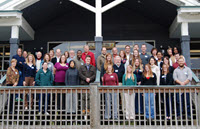
Nikaela’s experiences working with Dr. Sobecky have provided her opportunities to experience many aspects of microbial ecology as it relates to innovation, engagement, and advocacy efforts for women in STEM. She believes that her sharpened drive is a reflection of Sobecky’s own enthusiasm and passion for their research. “Dr. Sobecky always emphasizes the importance of reading older literature, as it contains much of the foundational theory that most metagenomic principles are based on today,” Nikaela said. “She is a consistent source of resources, mentorship, and encouragement, which are critical traits for a graduate advisor. It’s important that young scientists like myself have mentors like Dr. Sobecky who encourage us to be resilient in our research pursuits.”
One of Nikaela’s most memorable moments during her Ph.D. experience was attending the Women of Color STEM Entrepreneurship Conference hosted by the National STEM Collaborative, a consortium focused on supporting minority girls and women in STEM. Sobecky’s involvement with the Collaborative connected Nikaela with the conference and offered her a unique experience that she believes she couldn’t have found anywhere else. “Never before had I been around so many minority women with advanced STEM degrees and careers in one space,” she said. “The outpouring of encouragement from women in all aspects of STEM was amazing.”
Her Future
Nikaela currently works as a post-doctoral researcher in Sobecky’s lab and hopes to eventually work in an administrative position at a historically black college or university (HBCU) and give back to the community that introduced her to research. “I got my start at an HBCU. I feel like it’s my responsibility as a research scientist and educator to teach at an HBCU and provide the next-generation of research scientists with the same opportunities that I had and more,” she said.
Praise for Nikaela
Sobecky described Nikaela as a scientist who shows the strength, perseverance, and work ethic that advisors always hope to see develop in the students and postdocs they mentor. She praised Nikaela for always seeking to learn and bring new knowledge to her research projects. Nikaela’s drive to share science with others and invest in other upcoming scientists particularly stood out to Sobecky, who said “She is dedicated to paying it forward and helping others learn more about STEM and to helping them develop professionally. Nikaela embodies the consummate scientist and science educator that our nation needs to help solve societal issues.”
The GoMRI community embraces bright and dedicated students like Nikaela Flournoy and their important contributions. The GoMRI Scholars Program recognizes graduate students whose work focuses on GoMRI-funded projects and builds community for the next generation of ocean science professionals. Visit the ACER website to learn more about their work.
************
The Gulf of Mexico Research Initiative (GoMRI) is a 10-year independent research program established to study the effect, and the potential associated impact, of hydrocarbon releases on the environment and public health, as well as to develop improved spill mitigation, oil detection, characterization and remediation technologies. An independent and academic 20-member Research Board makes the funding and research direction decisions to ensure the intellectual quality, effectiveness and academic independence of the GoMRI research. All research data, findings and publications will be made publicly available. The program was established through a $500 million financial commitment from BP. For more information, visit https://gulfresearchinitiative.org/.
© Copyright 2010-2018 Gulf of Mexico Research Initiative (GoMRI) – All Rights Reserved. Redistribution is encouraged with acknowledgement to the Gulf of Mexico Research Initiative (GoMRI). Please credit images and/or videos as done in each article. Questions? Contact web-content editor Nilde “Maggie” Dannreuther, Northern Gulf Institute, Mississippi State University (maggied@ngi.msstate.edu).

Image of meiofaunal eukaryotes (Credit to Larry Hyde)
Meiofauna are invertebrate organisms that live in seafloor sediments. These marine creatures perform ecosystem functions such as trophic transfer, biogeochemical cycles, pollution removal, and sediment transport stability. Sensitive to environmental events such as oil spills, meiofauna are valuable bioindicators of impacts from contamination. However, their small size and our limited knowledge about these organisms’ community structure and taxonomy makes it difficult to track and characterize oil’s impacts.
The Gulf of Mexico Research Initiative recently awarded Dr. Kelley Thomas a grant to compile a reference genome database of benthic meiofaunal eukaryotes and establish Standard Operating Procedures (SOPs) for monitoring oil spills using bioinformatics. These tools can help researchers and responders interpret how spills might affect organisms in a particular area and how the organisms are expected to recover. “There’s so much we don’t understand about the relationship between the Gulf’s biogeochemical structure and the distribution of different taxa – we really don’t have any idea,” explained Thomas. “This information will help us better interpret the spill’s consequences and what kind of recovery will take place.”
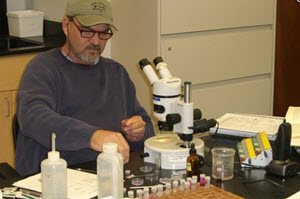
Larry Hyde reviews samples under a microscope. (Photo by Rick Kalke)
His team is analyzing as many individual benthic eukaryotes as they can using whole genome shotgun sequencing, a quick and economically-effective method for analyzing the structure of long DNA strands. The researchers are compiling the resulting data into a large database of reference genomes to identify biomarker genes based on their ability to identify changes in population and community structure. Once completed, they can sequence pre- and post-spill samples of the benthic community for the biomarker genes and identify which organisms and communities the spill impacted.
“In the mid-2000s, genetic sequencing technology rapidly advanced to allow us to run up to 200,000,000 sequences at a time when before we could only run about 100 sequences at a time,” explained Thomas. “The technology has steadily improved and gotten cheaper over time since then. That’s why today it is feasible to consider modeling the benthic Gulf of Mexico in a large-scale way just by conducting DNA sequencing and analyses.”
The project is also developing clear and concise SOPs for using the genome database to conduct environmental and oil spill monitoring. The open-source SOPs will target researchers without previous genomics experience to help train future scientists to understand the communities’ sediment biology and conduct big data analyses using bioinformatics. An annual workshop will introduce undergraduate and graduate students to the SOPs, from sample preparation to interpreting metagenomics and implementing bioinformatics.
“It’s not just microscopes anymore. Most of a researcher’s time is spent in front of a computer,” said Thomas. “The skills taught in this training will have more biological and environmental applications than just learning how to analyze Gulf of Mexico data.”
Thomas’s team is enthusiastic about the potential of their project’s products to offer analytic tools and facilitate academic progress in the field of biology. They hope to fill gaps in the current understanding of benthic eukaryote taxa, including information about their roles in the environment, their interactions, and even their viral histories. He explained that his team is very interested in the possibility of combining their work with that of other GoMRI projects. For example, combining their findings with the ongoing effort to describe the Gulf’s biogeochemistry and other such patterns and trying to link it to organismal patterns.
“We’re not just developing a practical resource. I believe that this database is going to contribute to and make a substantial impact on biology,” said Thomas. “This is going to be the way people will monitor those environments.”
The project’s researchers are W. Kelley Thomas of the University of New Hampshire Hubbard Center for Genome Studies, Holly M. Bik of the University of California – Riverside, and Paul A. Montagna of the Texas A&M University – Corpus Christi Harte Research Institute for Gulf of Mexico Studies. Their project is Genomic Responses to the Deepwater Horizon Event and Development of High-Throughput Biological Assays for Oil Spills.
************
The Gulf of Mexico Research Initiative (GoMRI) is a 10-year independent research program established to study the effect, and the potential associated impact, of hydrocarbon releases on the environment and public health, as well as to develop improved spill mitigation, oil detection, characterization and remediation technologies. An independent and academic 20-member Research Board makes the funding and research direction decisions to ensure the intellectual quality, effectiveness and academic independence of the GoMRI research. All research data, findings and publications will be made publicly available. The program was established through a $500 million financial commitment from BP. For more information, visit http://gulfresearchinitiative.org/.
© Copyright 2010- 2017 Gulf of Mexico Research Initiative (GoMRI) – All Rights Reserved. Redistribution is encouraged with acknowledgement to the Gulf of Mexico Research Initiative (GoMRI). Please credit images and/or videos as done in each article. Questions? Contact web-content editor Nilde “Maggie” Dannreuther, Northern Gulf Institute, Mississippi State University (maggied@ngi.msstate.edu).
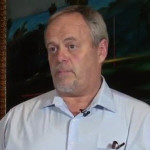
Researcher W. Kelley Thomas
The Genomic Responses to the Deepwater Horizon event and development of high-throughput biological assays for oil spills project is lead by W. Kelley Thomas, University of New Hampshire.
Within the GoM, the benthic environment is biologically hyper-diverse, performing critical ecosystem functions that have consequences for the ecology of the entire GoM region. Benthic communities are strongly impacted by oil spills, which render them a valuable tool for assaying and monitoring the impacts of contamination. However, the characterization of these communities has been impractical for large- scale deployment due to the tedious and time-consuming nature of the taxonomy required to accurately describe these communities. This project leverages recent and dramatic advances in DNA sequencing technology that have transformed the process of rapid, accurate, and cheap assays of community biodiversity. To achieve these goals, the project team brings together the interdisciplinary expertise in marine biology, taxonomy, genomics and bioinformatics necessary for the development of a meaningful and robust technology and has formulated three objectives.
Objective 1: Use targeted sequencing of individual benthic eukaryotes to generate a representative sample of diverse genomes from which to select an expanded set of nuclear and mitochondrial loci for targeted mining of shotgun metagenomic data.
Objective 2: Assess eukaryotic community structure across space and time via high-throughput sequencing of environmental metagenomes using a new and expanded array of nuclear and mitochondrial marker genes.
Objective 3: Establish Standard Operating Procedures (SOPs) and reproducible bioinformatic workflows for environmental monitoring of oil spills. This will include establishing a database for integration of taxonomic and molecular datasets, and dissemination of tools and educational resources.
Click for access to GoMRI’s YouTube videos of RFP-V Projects…
************
This project was funded by the Gulf of Mexico Research Initiative (GoMRI) in the RFP-V funding program.
The Gulf of Mexico Research Initiative (GoMRI) is a 10-year independent research program established to study the effect, and the potential associated impact, of hydrocarbon releases on the environment and public health, as well as to develop improved spill mitigation, oil detection, characterization and remediation technologies. An independent and academic 20-member Research Board makes the funding and research direction decisions to ensure the intellectual quality, effectiveness and academic independence of the GoMRI research. All research data, findings and publications will be made publicly available. The program was established through a $500 million financial commitment from BP. For more information, visit http://gulfresearchinitiative.org/.
 This factsheet explains not only what gene sequencing is and how it works but also how scientists use it to identify and compare bacteria in sediment samples.
This factsheet explains not only what gene sequencing is and how it works but also how scientists use it to identify and compare bacteria in sediment samples.
Remember back in high school biology when you studied genetics and learned about DNA, nucleotides and gene sequencing? Join us for this week’s Tool Talk as we clear away the cobwebs on gene sequencing and learn how Alabama Center for Ecological Resilience (ACER) scientists are using this process to study the microbial community composition.
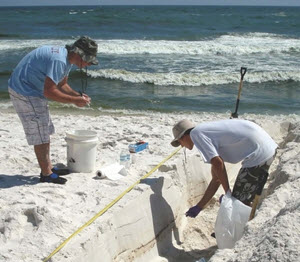
Jonathan Delgardio and Will A. Overholt (Georgia Institute of Technology) collect samples from a Pensacola Beach sand trench with oil layers. (Photo by Markus Huettel)
Genomics is a powerful method to track things that humans cannot see. Months and years after the Deepwater Horizon oil spill, many people wondered where the oil went or where it might be lingering or what it may affect after it was no longer visible. Scientists are using genomic techniques such as DNA sequencing to help answer some of these questions.
The Smithsonian posted an article featuring scientists Joel Kostka, Jack Gilbert, and David Portnoy. Kostka’s work focuses on using genetic markers of microbes to determine whether or not shorelines have been affected by the oil spill. Gilbert’s work focused on identifying microbes who feed on carbon as a way to determine if oil is being degraded in environments such as sediment. Portnoy’s work focuses on detecting possible long-term impacts on fish that live in waters exposed to the oil spill.
Read the Ocean Portal article to learn how genomics help us understand oil spill impacts.
For more information about oil spill research that employs genomics, read:
************
GoMRI and the Smithsonian have a partnership to enhance oil spill science content on the Ocean Portal website.
The Gulf of Mexico Research Initiative (GoMRI) is a 10-year independent research program established to study the effect, and the potential associated impact, of hydrocarbon releases on the environment and public health, as well as to develop improved spill mitigation, oil detection, characterization and remediation technologies. An independent and academic 20-member Research Board makes the funding and research direction decisions to ensure the intellectual quality, effectiveness and academic independence of the GoMRI research. All research data, findings and publications will be made publicly available. The program was established through a $500 million financial commitment from BP. For more information, visit http://gulfresearchinitiative.org/.
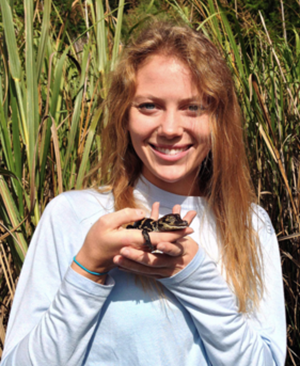
Lexi poses with a baby alligator during an alligator release trip. Other graduate students Lexi works with treat alligator eggs with mixtures of oil, Corexit, and other environmental contaminants to assess their effects on development. Lexi enjoys taking a break from the lab to help on release and egg collection trips. (Provided by: Lexi Temkin)
Unhealthy diet and inactivity are the first things that people think about that cause obesity.
However, Alexis Temkin is finding an unexpected potential contributor to increased fat cell production: a component in dispersants used for oil spill cleanup and many personal care products. She is excited to share her stories about the scientific detective work that is unfolding right now.
Lexi’s research melds medicine and marine science to help researchers and doctors better understand the impacts of oil spill compounds on the determination of human cell type. She hopes to influence the way chemical safety is approached, “Our group wants to improve testing for sublethal effects, such as fat cell production rates, when assessing certain chemicals. It’s a different way to think about safety and health.”
Lexi is a marine biomedicine and environmental sciences Ph.D. student at the Medical University of South Carolina and a GoMRI Scholar with the project Using Embryonic Stem Cell Fate to Determine Potential Adverse Effects of Petroleum/Dispersant Exposure. She shares her scientific journey and the places it could take her.
Her Path
Lexi’s story begins as a child who always enjoyed learning about the natural world. She describes herself as “that kid on the beach who would pick up all the bugs and fish” and gravitated toward science classes, particularly marine science and human health. Her varied interests made it challenging to answer every high school student’s least favorite question: what do I want to be when I grow up? While Lexi’s first instinct was to become a doctor, she could not shake her interest in marine science. She found ways to study both subjects as an undergraduate at Connecticut College. The more courses she took, the more she realized her true calling. “I genuinely liked medicine, but I became more interested conducting research than treating patients,” she says. “I think ‘be a doctor’ was an easier answer when I was a teenager than ‘be a research scientist’ because at that age you don’t really think of research as a career.”
While studying abroad at James Cook University in Australia, Lexi learned about marine biomedicine, which examines the potential of natural marine products to treat human diseases. It was the perfect marriage of her two major interests. She was able to get hands-on experience at the Harbor Branch Oceanographic Institute through Florida Atlantic University’s Summer Internship Program, researching how natural products isolated from bacteria in marine sponges could inhibit cell proteins associated with pancreatic cancer. Knowing this was the field for her, Lexi enrolled in the Medical University of South Carolina’s Marine Biomedicine and Environmental Sciences graduate program. There, she met Dr. Demetri Spyropoulos who had just begun GoMRI research on the molecular-level effects of oil and Corexit exposure on human health. “Since the grant had just started, we could ask a lot of different questions and watch the story unfold,” says Lexi. “It’s a very discovery-based science, and I love that.”
Her Work
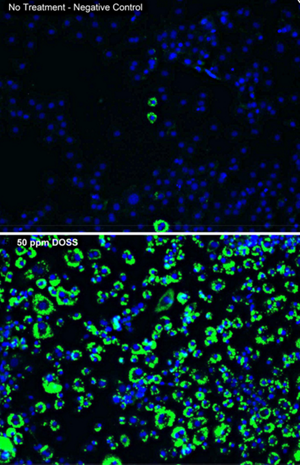
Images were taken from the fluorescent microscope Lexi used to measure the “fatness” of cells. She stained the cells with different colors of fluorescent dyes, which bound to the cell’s triglycerides or nuclei. Computer software linked to a fluorescent microscope counted the photons given off by the dyes to count cells and triglyceride levels. Here, cell nuclei are indicated by blue light and triglycerides are indicated by green light. These images depict cells with no exposure to oil or dispersant (above) and cells exposed to DOSS (below). (Provided by: Lexi Temkin)
Lexi’s study searches for compounds in crude oil, dispersed oil, and Corexit dispersant that can act as obesogens. Obesogens are chemicals that encourage stem cells to become fat cells by activating a receptor (fat cell differentiation). Previous and current research has shown that environmental exposure to certain chemicals (obesogens) can alter gene expression and cause fat cell differentiation. Lexi is using cell-based tools to ask if certain fractions of crude oil, dispersed oil, or dispersant contain obesogens.
Lexi refers to the detective part of her research as a “fishing expedition,” during which she devoted her energy to searching for possible obesogens among the many chemicals contained in oil and Corexit dispersant. One of her cell-based tools used bioluminescent transcription assays to help identify obesogen chemicals. She found that only cells in mixtures containing Corexit exhibited receptor activation. An assessment of the dispersant’s components narrowed her search to DOSS – a major component of Corexit formulations.
With this new information, Lexi used another cell-based tool to see how different DOSS concentrations drove fat cell production. She explained that you can actually see the cells increase in triglycerides and gain lipid droplets as they differentiate into fat cells. She measured the cell’s triglyceride levels and found that cells exposed to more DOSS were indeed “fatter” than those that had less or no DOSS exposure. Lexi and her team are collaborating with epidemiologists focused on human exposure to the Deepwater Horizonoil spill to identify biomarkers of DOSS exposure in human stem cells, humans, and mouse and alligator animal models.
Lexi is confident about the impact her research could have on preventative medicine. Information about the ways certain chemicals impact human health can help people make lifestyle choices that reduce their exposures and could even counteract negative effects. “Some people might see these findings as doom and gloom, but knowing the risks of exposures and how to avoid them should be empowering!”
Our partners at the Smithsonian Ocean Portal featured Lexi and her research in honor of Women’s History Month.
Her Learning
Lexi’s GoMRI experience has taught her the importance of being open-minded and communicating with other researchers. She encourages talking to people outside of one’s field, because they may offer a new perspective to your work. “I’d never worked with oil before, and we were unsure how to dose our cells,” says Lexi. “However, when we talked to people who work with oil and dispersants every day, they knew exactly which methods we should use and which mixtures to make.” Lexi emphasized the value of events like the Oil Spill and Ecosystem Science Conference. “GoMRI does an amazing job connecting different scientific communities and keeping everyone informed of what each other is doing,” she explains. Researchers from many different fields and backgrounds are brought together. It’s an incredible environment to work in, and I’m thankful for that.”
One of Lexi’s favorite memories is the moment she realized her research could improve not only our understanding of safer oil spill cleanup, but also medical practices. She and her team often collaborate with Reproduction, Endocrinology, and Childhood Health (REACH) – a research group studying environmental effects on children’s health. She presented a lecture explaining how embryos could develop a predisposition to obesity due to chemical exposure in the womb and detailing her DOSS research. A physician in the audience mentioned that doctors often prescribe laxatives containing DOSS to pregnant women, opening Lexi’s eyes to the potential scope of her research. “When we started our research, we didn’t know where this story was going to go,” reflects Lexi. “Human exposure to DOSS through an oil spill may generally be minimal, but if you’re a pregnant woman your exposure could come from many different sources. It was another moment when just talking to people could make this a completely different story.” Working with the REACH group, Lexi plans to compare fat levels and molecular markers in children whose mothers did and did not take these laxatives while pregnant.
Her Future
Lexi aims to complete her Ph.D. by the end of 2016. After graduation, she wants to get involved with education and community outreach opportunities in her field to help communicate knowledge about environmental exposures and their contributions to disease. “I think a lot of the science is out there, but people don’t know about it,” she says. Lexi is also interested in becoming a professor and teaching at the undergraduate level.
Reflecting on her journey, Lexi offered some advice for those considering a career in science. “It’s really easy to change fields, especially when you’re young. Trying different things is a good way to figure out what you want to do,” says Lexi. “Just because you do one type of research in college, it doesn’t mean that you’re locked into that one thing.” She encourages students who are curious about research to approach their professors and ask if they can get involved in on-going studies, “If you have even the slightest bit of interest in something, pursue it.”
Praise for Lexi
Lexi’s advisor, Demetri Spyropoulos, is enthusiastic about her potential as a scientist and researcher. He explained that Lexi stands out from other graduate students due to the innovation and exciting possibilities behind her project. “A mixture of sea water, Corexit, and Gulf oil is an incredibly complex mixture of components,” he explained. “It’s quite astounding that Lexi could determine that there was a potential ‘obesogen’ in the mix and be able to zero in on a single component.” He also noted that Lexi’s DOSS research has and will benefit greatly from her people-person skills, “We use some very sophisticated equipment and technologies, and Lexi is just as at home in these settings as she is when she’s getting news reporters and students excited about her project’s potential.”
Spyropoulos is proud to note that Lexi has not only done some great research, but also “brought it to a point at which they can ask some tough questions of safety: whether there are lasting impacts of exposure and, if so, what doses/exposures cause these impacts.” He explained that she can look for persistent DOSS-specific changes that identify people who have been exposed, the extent of their exposure, and impacts on their health. “She really wants to make a positive mark in this world and help the life in it,” he said. “And she’s running on all cylinders to make that happen.”
The GoMRI community embraces bright and dedicated students like Lexi Temkin and their important contributions. TheGoMRI Scholars Program recognizes graduate students whose work focuses on GoMRI-funded projects and builds community for the next generation of ocean science professionals.
Visit the department website to learn more about their work.
************
This research was made possible in part by a grant from BP/The Gulf of Mexico Research Initiative (GoMRI) to the Using Embryonic Stem Cell Fate to Determine Potential Adverse Effects of Petroleum/Dispersant Exposure. The GoMRI is a 10-year independent research program established to study the effect, and the potential associated impact, of hydrocarbon releases on the environment and public health, as well as to develop improved spill mitigation, oil detection, characterization and remediation technologies. An independent and academic 20-member Research Board makes the funding and research direction decisions to ensure the intellectual quality, effectiveness and academic independence of the GoMRI research. All research data, findings and publications will be made publicly available. The program was established through a $500 million financial commitment from BP. For more information, visit http://gulfresearchinitiative.org/.